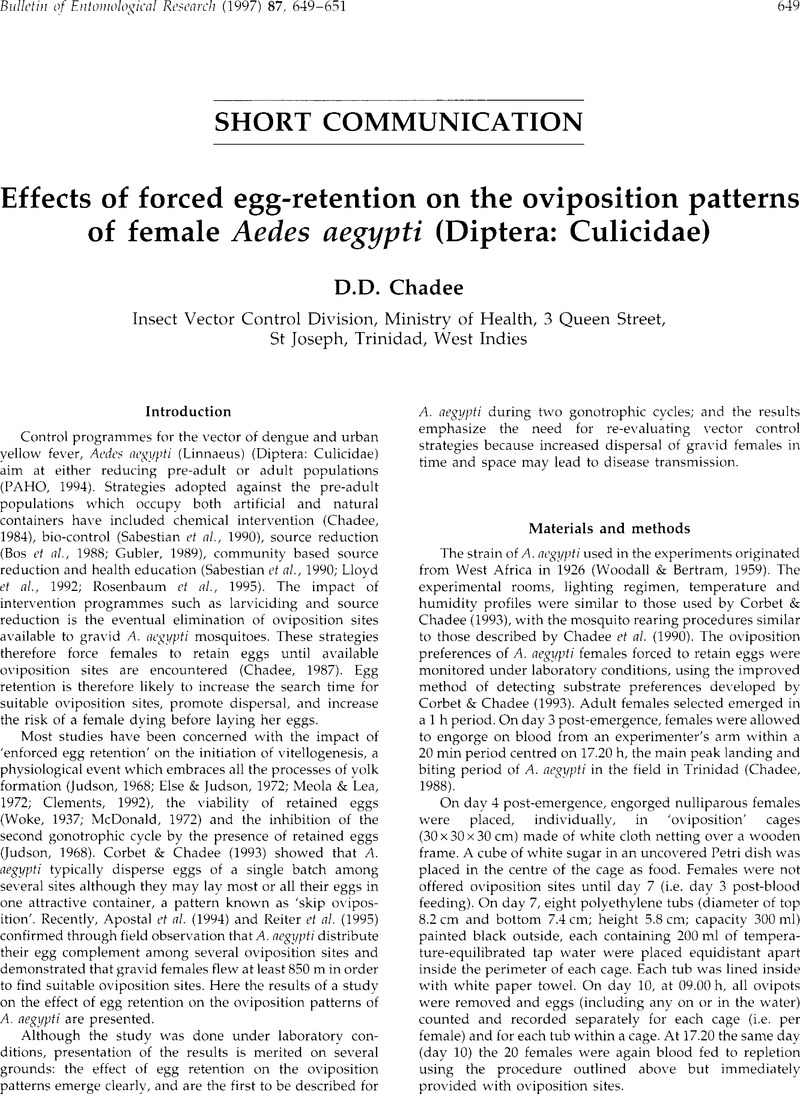Crossref Citations
This article has been cited by the following publications. This list is generated based on data provided by Crossref.
Harrington, Laura C.
and
Edman, John D.
2001.
Indirect Evidence Against Delayed "Skip-Oviposition" Behavior byAedes aegypti(Diptera: Culicidae) in Thailand.
Journal of Medical Entomology,
Vol. 38,
Issue. 5,
p.
641.
Ganesan, Kumaran
Mendki, Murlidhar J
Suryanarayana, Malladi V S
Prakash, Shri
and
Malhotra, Ramesh C
2006.
Studies of Aedes aegypti (Diptera: Culicidae) ovipositional responses to newly identified semiochemicals from conspecific eggs.
Australian Journal of Entomology,
Vol. 45,
Issue. 1,
p.
75.
Otero, Marcelo
Schweigmann, Nicolás
and
Solari, Hernán G.
2008.
A Stochastic Spatial Dynamical Model for Aedes Aegypti.
Bulletin of Mathematical Biology,
Vol. 70,
Issue. 5,
p.
1297.
Chadee, D.D.
2009.
Oviposition strategies adopted by gravid Aedes aegypti (L.) (Diptera: Culicidae) as detected by ovitraps in Trinidad, West Indies (2002–2006).
Acta Tropica,
Vol. 111,
Issue. 3,
p.
279.
Sharma, Kavita R.
Seenivasagan, T.
Rao, A. N.
Ganesan, K.
Agrawal, O. P.
and
Prakash, Shri
2009.
Mediation of oviposition responses in the malaria mosquito Anopheles stephensi Liston by certain fatty acid esters.
Parasitology Research,
Vol. 104,
Issue. 2,
p.
281.
Seenivasagan, T.
Sharma, Kavita R.
Ganesan, K.
and
Prakash, Shri
2010.
Electrophysiological, Flight Orientation and Oviposition Responses of Three Species of Mosquito Vectors to Hexadecyl Pentanoate: Residual Oviposition Repellent Activity.
Journal of Medical Entomology,
Vol. 47,
Issue. 3,
p.
329.
Chadee, D.D.
2010.
The diel oviposition periodicity of Aedes aegypti (L.) (Diptera: Culicidae) in Trinidad, West Indies: effects of forced egg retention.
Bulletin of Entomological Research,
Vol. 100,
Issue. 5,
p.
599.
Seenivasagan, T.
Sharma, Kavita R.
Ganesan, K.
and
Prakash, Shri
2010.
Electrophysiological, Flight Orientation and Oviposition Responses of Three Species of Mosquito Vectors to Hexadecyl Pentanoate: Residual Oviposition Repellent Activity.
Journal of Medical Entomology,
Vol. 47,
Issue. 3,
p.
329.
Seenivasagan, Thangaraj
Guha, Lopamudra
and
Iqbal, S. Thanvir
2013.
Behavioral and electrophysiological responses of Culex quinquefasciatus to certain fatty acid esters.
Acta Tropica,
Vol. 128,
Issue. 3,
p.
606.
Souza, Gabriely K
Pikart, Tiago G
Zanuncio, Teresinha V
Wilcken, Carlos F
Serrão, José E
and
Zanuncio, José C
2014.
Reproductive Tract Histology of Thaumastocoris peregrinus (Hemiptera: Thaumastocoridae).
Annals of the Entomological Society of America,
Vol. 107,
Issue. 4,
p.
853.
Artis, Monica L
Huestis, Diana L
and
Lehmann, Tovi
2014.
The effects of oviposition-site deprivation on longevity and bloodfeeding rate in Anopheles gambiae.
Parasites & Vectors,
Vol. 7,
Issue. 1,
Chadee, Dave D.
and
Gilles, Jeremie R.L.
2014.
The diel copulation periodicity of the mosquito, Aedes aegypti (L.) (Diptera: Culicidae) at indoor and outdoor sites in Trinidad, West Indies.
Acta Tropica,
Vol. 132,
Issue. ,
p.
S91.
Satho, Tomomitsu
Dieng, Hamady
Ahmad, Muhammad Hishamuddin Itam
Ellias, Salbiah Binti
Hassan, Ahmad Abu
Abang, Fatimah
Ghani, Idris Abd
Miake, Fumio
Ahmad, Hamdan
Fukumitsu, Yuki
Zuharah, Wan Fatma
Majid, Abdul Hafiz Ab
Kassim, Nur Faeza Abu
Hashim, Nur Aida
Ajibola, Olaide Olawunmi
Al-Khayyat, Fatima Abdulla
and
Nolasco-Hipolito, Cirilo
2015.
Coffee and its waste repel gravid Aedes albopictus females and inhibit the development of their embryos.
Parasites & Vectors,
Vol. 8,
Issue. 1,
Rund, Samuel
O’Donnell, Aidan
Gentile, James
and
Reece, Sarah
2016.
Daily Rhythms in Mosquitoes and Their Consequences for Malaria Transmission.
Insects,
Vol. 7,
Issue. 2,
p.
14.
Reinbold-Wasson, Drew David
Reiskind, Michael Hay
and
Yee, Donald
2021.
Comparative Skip-Oviposition Behavior Among Container BreedingAedesspp. Mosquitoes (Diptera: Culicidae).
Journal of Medical Entomology,
Vol. 58,
Issue. 6,
p.
2091.
Dieng, Hamady
McLean, Storm
Stradling, Holly
Morgan, Cole
Gordon, Malik
Ebanks, Whitney
Ebanks, Zoila
and
Wheeler, Alan
2022.
Aquatain® causes anti-oviposition, egg retention and oocyte melanization and triggers female death in Aedes aegypti.
Parasites & Vectors,
Vol. 15,
Issue. 1,
Custódio, Jane Larissa de Melo
Jorge, Jean Patrick da Silva
Jorge, Jaqueiuto da Silva
Freire, Renato César de Melo
Brambilla, Paula Blandy Tissot
Guariento, Rafael Dettogni
Caliman, Adriano
and
Carneiro, Luciana Silva
2024.
Predation risk and resource availability interactively affect the oviposition behavior of Aedes aegypti.
Hydrobiologia,
Vol. 851,
Issue. 16,
p.
3869.



